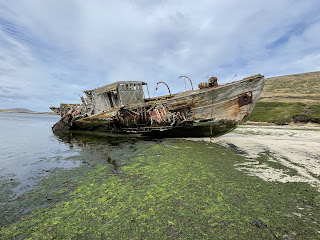Falkland Islands
The Falklands Islands are an archipelago off the southern tip of South America. There are more than 740 islands, most of them uninhabited. The population is less than 4,000, with more than half in the capital, Port Stanley. Since there are so few people, many species of animals, mainly seabirds, breed on the islands. The total land area is about 4500 square miles, most on East and West Falkland Islands. The Falklands are a windy environment, with poor soil and few native trees, mostly low shrubs. However, oil and gas have been discovered, but the cost of extraction compared to the price of oil has not justified exploitation to date. Also, there is a water shortage on the islands, barely enough to support the current population. There are some sheep farms, producing high quality wool and meat, but the sheep require more than double the acreage per sheep compared to other sheep producing areas, so it is not a large industry.
The isolation of the islands, and ongoing disputes over sovereignty between Argentina and the UK, including the infamous 74 day war in 1982, when Argentina invaded the islands, but were ultimately defeated by the UK, means there are few flights, only one per week at the current time. The flight is staged out of Chile, since Argentina will not allow flights from Argentina to the Falkland Islands and sometimes flights to there are denied entry into Argentinian airspace.
Our reasons for stopping in the Falkland Islands included more wildlife encounters, with several new species of penguins possible, other species of seabirds, touring the city of Port Stanley, a little piece of Britain overseas, and learning about the history, including european discoveries and claims, settlements and ultimately disputes over who owns the archipelago.
Thursday, February 16, 2023 – Port Stanley
After two days at seas, with some rough seas and high winds, Seabourn Quest entered the anchorage off of Port Stanley at 0700 and anchored about one mile from the tender dock. The inner harbor is too small for our ship, so were tendered in by the ship’s tenders. Clearance took some time, so shore excursions were all delayed. Miriam elected to remain on board while Patrick went on a 7 hour wildlife encounter via 4x4 vehicles.
The encounter took place at Seal Bay, on the north coast of East Falkland Island. After a one hour drive we headed off road in seven 4x4 vehicles containing either 3 or 4 passengers. The terrain was across extensive peat bogs and even across shallow lakes until we reached the cliffs along the coast. Our first stop provided views of Rockhopper Penguins, Imperial Cormorants, Upland Geese, Caracara’s and Skuas. The second stop was down on the beach where we visited a Gentoo Penguin colony and had a snack before heading back to the ship. Due to the clearance delays and the length of the tour, we barely made the last scheduled tender back to the ship, so had limited views of Port Stanley.
Lonely Gentoo penguin chick on beach
Friday, February 17, 2023 – New Island
New Island is a nature conservancy on the far western edge of the archipelago. It is home to more than 40 species of birds. Seabourn Quest anchored in one of the eastern bays, sheltered from the wind and commenced operations at 0730, with both Zodiac tours ashore and kayaking. Patrick went kayaking, seeing Magellanic Penguins, Gentoo Penguins, Imperial Cormorants, Peale’s Dolphins, Giant Southern Petrels, Prions, Caracara’s, and an abandoned whaling station and the group was even followed by an Elephant Seal. Following the Kayak tour, the zodiac trip ashore to a beautiful sandy beach followed a 1 kilometer marked path to an incredible Black Browed Albatross rookery, with many young chicks. Mixed in with the albatrosses were more Rockhopper Penguins, Caracara’s, Peregrine Falcons and several species of Shags, more Upland Geese and several other bird species such as Thrushes, Prions and Kelp Geese,
Kelp Gull - New Island
By noon everyone who wanted to go ashore had done so, the anchor was weighed and we set course for the 1000 NM voyage to Montevideo, Uruguay. As we left, there were dozens of Sei whales close to the ship, more dolphins and many Southern Fur Seals.














No comments:
Post a Comment
Note: Only a member of this blog may post a comment.